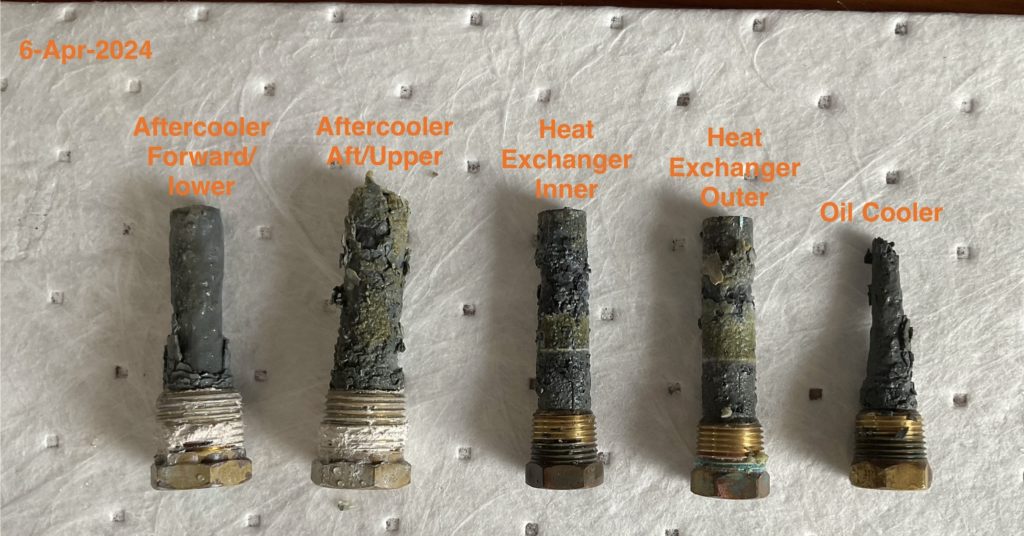Not much to report on this one… I’m glad this stuff is starting to become at least a little routine.
Engine Anodes
Surprisingly little drama on this one. The whole job took about 20 minutes, with a fair amount of puttering and lollygagging. When removing the gear cooler anode, the cap unscrewed, almost getting it stuck. But, I was able to screw it back in and the whole things came out. 155 hours since last change and the timing seemed about right. The main engine sea water intake valve was hard closing (but easy opening with the little tool I bought – basically an overpriced piece of PVC with a slot in is that you put over the lever to get more, er, leverage). Note that only the aftercooler zincs call for pipe dope.

Sea Strainer
Surprisingly clean. I rinsed it out in fresh water and a few bits came out, but otherwise looked good. The cap has been sticky, so I added a little silicone lubricant to the gasket and it went on much easier.



Main Engine Oil
Total system capacity is about 17 quarts, but I exchanged about 13. Even with the oil pump pulling air, there’s ~4 quarts up in there somewhere. This time I filled to 11 plus a quart for the filter, ran the engine to 5 min, and then added 1 more quart until the dipstick was on full. Straight-forward.


Main Engine Secondary Fuel Filter
I hate dealing with diesel. No matter how careful I am I always spill some. I took the filter off and tried to pour it into an empty oil container, but I managed to spill some anyway. Luckily I had petroleum soaks everywhere, so it wasn’t too bad to clean up. But, now I have about a quart of diesel no one will take (the auto parts store will take oil, but not diesel – maybe the dump under the hazardous waste rules?). I may use it to prime the other filters when I change them. I switched from a Fleetguard filter to a Baldwin from Fisheries. I have no preference, it was just what’s available.
Also, I learned how to prime. I installed the filter empty and then turned the key to the “on” position without turning the engine over. This runs the fuel pump for 30 seconds. I did this six times and the engine started right up.
Generator Oil and Filter
I hate how Northern Lights puts the filter and fill port on the side. There’s no way to take it off without dribbling some oil. And, when filling, it tends to dribble out unless you pour it really slowly. Other than that, it was a straight-forward job. Turned around 2.5 quarts on a total capacity of 3 quarts. I transferred the new oil from the gallon jugs into a 16 oz. cup with a pour spout so I could track how much went in and to spill less.
Clean Up
I cleaned the sea water out of the bilge (from the anodes) and wiped up all the spilled oil and diesel. For the most part, there was very little. I wiped up the bilge and vaccumed the engine and around the hatches (mostly dog hair). The auto parts store took the oil, but I wouln’t take the diesel, so it’s in a jug in the garage.
I usually put several petroleum soaks in the 5 gallon bucket I use for oil and let them soak up the residual oil. It’s not clear to me what I am supposed to do with all the empty oil jugs, spent (empty) filters, and dirty petroleum soaks. I usually just put them in the normal trash, but I am sure there must be some rules. Given how little I can find about disposing of diesel, they really don’t make it easy.
I still need to change the fuel filters on the generator and the hydronic. Those need to be manually primed (e.g. pour diesel into them) so the job will probably be messy. The water maker is almost due for a high pressure pump oil change, but I checked it today at it’s at the mark in the site gauge and still looks quite clean, so I may wait until it alarms at 50 hours to change it.
The engine manual says I need to clean and service the aftercooler, so I’ll add that to the someday list as well.
Kind of a fun, relaxing, zen day in the engine room.
